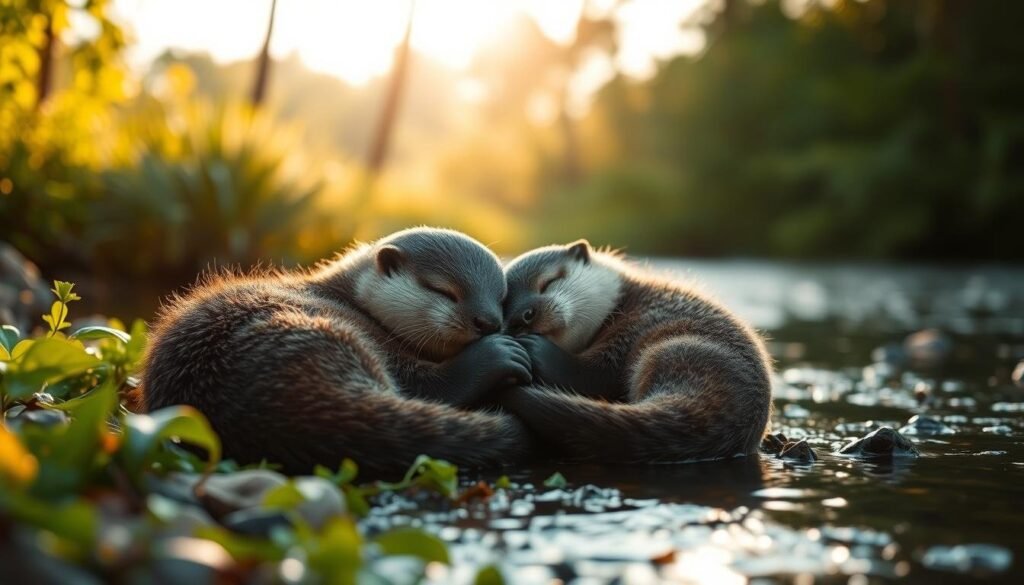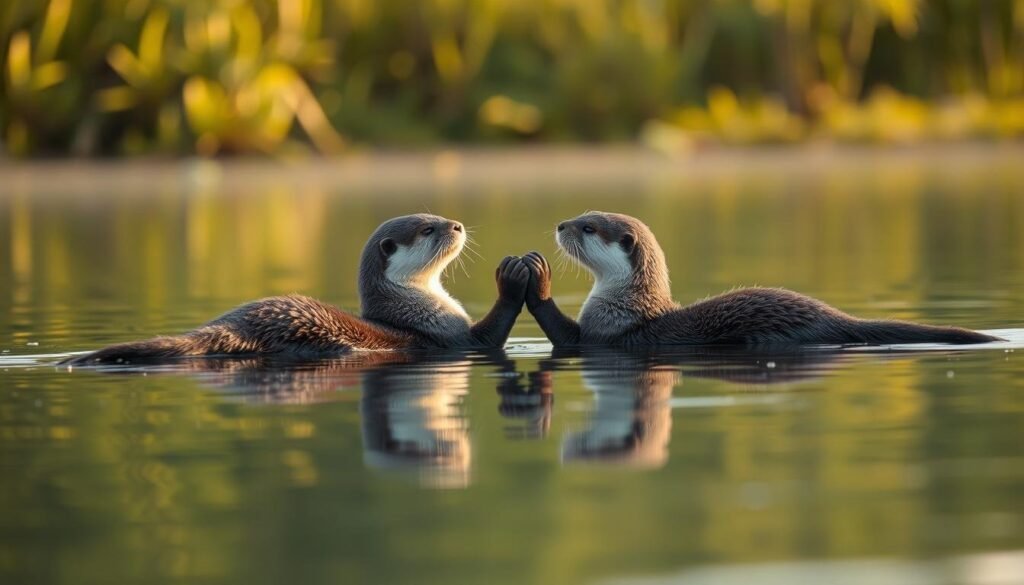Why Otters Hold Hands While Sleeping? You’ve probably seen cute pictures of otters floating together, holding hands as they sleep. This adorable behavior has won the hearts of many who love wildlife. It also makes people curious about the science behind it.
Exploring the world of otters, you’ll learn about their special sleeping habits and social behavior. Otters are known for being playful. Their hand-holding while sleeping is just one part of their interesting social life.
Learning why they do this will give you a peek into the amazing world of these water mammals. You’ll also understand the efforts to save them.
Contents
- 1 The Charming World of Otters
- 2 Why Do Otters Hold Hands While Sleeping?
- 3 The Science Behind Otter Hand-Holding
- 4 Otter Conservation and Human Impact
- 5 Understanding Otter Behavior and Conservation
- 6 FAQ: Why Otters Hold Hands While Sleeping?
- 6.1 Why do otters hold hands while sleeping?
- 6.2 What is the significance of social bonding in otter behavior?
- 6.3 How do otters adapt to their environments?
- 6.4 What are the main threats facing otter populations?
- 6.5 How can humans contribute to otter conservation?
- 6.6 What is the role of oxytocin in otter social bonding?
The Charming World of Otters
Otters live in complex social groups, called “romps.” These groups usually have a female otter and her kids. This shows a strong bond between mothers and their young.
Otters can be found in rivers, lakes, and by the sea. Their home greatly influences their behavior. For example, sea otters use rocks to open shells in the Pacific.
There are many types of otters, like the Eurasian and giant otters. Each has its own special traits. They eat fish, crustaceans, and mollusks, which helps them survive.
Watching otters in the wild is fascinating. They love to play, sliding down rocks or fighting. This play is key to their learning and growth.
Understanding otter behavior is vital for wildlife conservation. Sea otters, as marine mammals, are crucial to their ecosystems. By studying them, we learn how to protect their homes and the challenges they face.
Why Do Otters Hold Hands While Sleeping?
Otters holding hands while sleeping is more than cute. It’s about safety, companionship, and survival. They rest in places like kelp forests where strong currents can pull them apart. So, they stay together as a family group.
One main reason is to prevent drifting apart. Otters float on their backs, wrapped in kelp or seaweed. This keeps them from being swept away by currents.
Preventing Drift Apart
By holding hands, otters stay together, even when resting or sleeping. This is key for their survival. Being alone could make them more vulnerable to predators or harsh conditions.

Holding hands also strengthens their social bonds. Otters are social creatures that love interaction and affection. This behavior shows trust and affection, making their family bonds stronger.
The table below summarizes the key reasons why otters hold hands while sleeping:
| Reason | Description | Importance |
|---|---|---|
| Preventing Drift Apart | Otters hold hands to stay together in strong currents. | High |
| Social Bonding | Holding hands strengthens family bonds and trust. | High |
| Safety and Security | Being together provides additional protection. | Medium |
Understanding otters’ behavior gives us insight into their social lives. Their sleeping habits show the importance of family bonds in their lives.
The Science Behind Otter Hand-Holding
Exploring otters reveals their hand-holding is complex. It’s shaped by biology. Otters are marine mammals living in water, with traits for aquatic life.
Their fur is key. Otters have the thickest fur, up to 1 million hairs per square inch. This keeps them warm in cold water. But, it needs constant grooming to stay untangled. This grooming strengthens their social bonds.
| Physiological Trait | Description | Benefit |
|---|---|---|
| Thick Fur | Up to 1 million hairs per square inch | Insulation in cold water |
| Webbed Feet | Adaptation for propulsion in water | Efficient swimming |
| Oxytocin | Hormone involved in social bonding | Strengthens otter relationships |
Oxytocin is important in otter bonding. Known as the “love hormone,” it helps them bond. It’s thought to play a big role in their hand-holding.
Otters also have webbed feet for swimming. Their senses, like vision and touch, help them survive underwater. These traits are crucial for their aquatic life.
In summary, otter hand-holding is complex. It involves their biology, physiology, and social behavior. Understanding this helps us value these marine mammals and the need for animal conservation.
Otter Conservation and Human Impact
Otters’ survival is closely tied to the health of their ecosystems. These ecosystems are facing threats from human actions.
Otters face many challenges, like habitat loss, pollution, and hunting. Habitat loss, mainly from deforestation and urban growth, cuts down their living space. Pollution, especially from industrial and farm waste, harms their water homes and food sources.
- Habitat restoration: Making habitats healthy again for otters.
- Research initiatives: Learning about otter behavior and habitats to help protect them.
- Community engagement: Teaching local people why otters need protection and getting them involved.
You can help otters by supporting groups that restore habitats and conduct research. Also, spread the word about otters’ struggles. Push for laws that safeguard wildlife habitats.
Understanding Otter Behavior and Conservation
Otters hold hands while sleeping to stay together. This shows their need for connection and safety. It’s not just cute; it’s essential for their survival.
Protecting otters and their homes is key. Supporting conservation groups helps keep their habitats safe. Learning about otters’ hand-holding can deepen our appreciation for them.
Wildlife conservation is vital. It helps keep ecosystems balanced, supporting otters and other animals. Your actions can help ensure their survival.
See Also: Discover Why Walruses Slap Water with Flippers
FAQ: Why Otters Hold Hands While Sleeping?
Why do otters hold hands while sleeping?
Otters hold hands to stay together while sleeping. They rest in places like kelp forests where strong currents can pull them apart.
Social bonding is key for otters. It helps them stay close as a family. This is important for their survival.
How do otters adapt to their environments?
Otters have special features to live well in their homes. They have thick fur, webbed feet, and sharp senses.
What are the main threats facing otter populations?
Otters face dangers like lost homes, pollution, and hunting. These threats harm their homes and numbers a lot.
How can humans contribute to otter conservation?
People can help otters by supporting conservation. This includes fixing their homes, studying them, and teaching others. We can also choose green options.
Oxytocin is important for otter friends. It makes them feel safe and close. This helps their group bond stronger.

Zyair Larson, based in Denver, Colorado, has over 12 years of experience studying animal behavior. He has worked with the World Wildlife Fund (WWF) and National Geographic, researching wildlife and sharing insights on animal habits globally.

